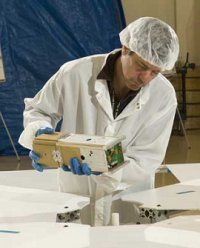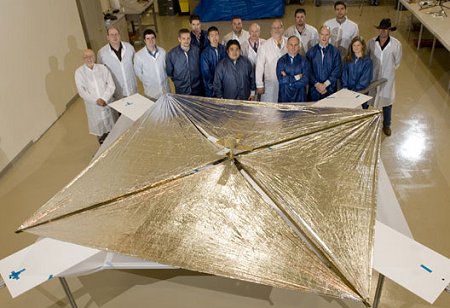NASA’s Marshall and Ames Research Centers will team up with the commercial space company SpaceX to launch and deploy a solar sail this summer. A bread-box sized payload called NanoSail-D will travel to space onboard a SpaceX Falcon 1 Rocket and if all goes well, it will be the first fully deployed solar sail in space, and the first spacecraft to use a solar sail as a primary means of orbital maneuvering. The first launch window is from July 29th to August 6th, with a back-up window extending from August 29th to September 5th. Weighing less than 4.5 kilograms (10 pounds) the aluminum and plastic sail has about 9.3 m² (100 square feet) of light-catching surface which researchers hope will successfully propel the spacecraft.
Solar sails have been the stuff of dreams for years. Because there’s no friction in space, once a solar sail starts moving, it can go on forever. While rockets would run out of gas and begin to coast, a spaceship powered by solar sails would continue accelerating as long as there is a solar wind, reaching faster speeds and covering distances far greater than any rocket. No rocket has been invented that could carry enough fuel to reach the outer solar system in as short a time. And like a marine sail, a solar sail could also bring you home. You could use the solar sail to travel “against the wind,” back to Earth.

“It’s not so much about how far a sail will go compared to a rocket; the key is how fast,” says Edward “Sandy” Montgomery of NASA’s Marshall Space Flight Center. “The Voyagers have escaped the solar system, and they were sent by rockets, but it’s taken more than three decades to do it. A sail launched today would probably catch up with them in a single decade. Sails are slower to get started though. So, for example, between the Earth and the moon, rockets might be preferred for missions with a short timeline. It’s a trip of days for rockets, but months for a solar sail. The rule of thumb, therefore, would be to use rockets for short hops and solar sails for the long hauls.”
Previous attempts to launch and deploy a solar sail in space have met limited success. In 2004 Japan launched prototype solar sails that deployed, but they weren’t used for propulsion. The Planetary Society attempted a solar sail launch in 2005, called Cosmos 1, but the Russian launch vehicle failed to reach orbit. NASA did successfully deploy a solar sail in a vacuum chamber in 2004, but of course, its propulsive capability wasn’t able to be tested.
Montgomery believes a successful mission would be huge for the future of spaceflight. If successful, solar sails could potentially help with a growing problem of space debris.
“Currently, micro-satellites in orbit above a few hundred kilometers can stay in orbit for decades after completing their mission,” Montgomery said. “This creates an orbital debris collision risk for other spacecraft. NanoSail-D will demonstrate the feasibility of using a drag sail to decrease the time satellites clutter up Earth’s orbit. Although our sail looks like a kite, it will act like a parachute (or like a drag sail) in the very thin upper atmosphere around Earth. It will slow the spacecraft and make it lose altitude, re-enter the Earth’s atmosphere and burn off in a relatively short period of time. A drag sail is a lighter alternative to carrying a propulsion system to de-orbit a satellite.”
Movie of how NanoSail D will unfurl.
Original News Source: Science at NASA


Hm, interesting, I always thought solar sails sail the solar wind not the light, but learned now, that it is the exact oposite. In WIkipedia I found this quote: “Magnetic sails are propelled almost entirely due to the force of the solar wind. Solar sails are propelled almost entirely due to the force of the sun’s EM radiation, not the solar wind.”
I still do not quite understand though how it could be used to sail against the source of the light. I do not think that the same priciple as at sailboats can be applied here.
OK, I found how to sail against the Sun – by spiraling down the orbit around the Sun by thrusting against its orbital motion.
Let’s get this technology cracking! Then we may have more than a fighting chance of covering some real space mileage!
The sail is not suspended by the light any more than a boat is suspended in the water by its canvas.
So I think Trux might have something, in that if you can use this to alter your ships orbital speed then gravity should carry you inward or outward over time.
The density of EM radition decreses exponentially with distance from the sun and therefore the ‘push’ will diminish over the longer distance from sun, it will still be a push but it may be an exaggeration to say that for long haul space travel solar sail would take lower time than rockets.
The best option is to use hybrid technology; catch up a good early speed with rockets, may or may not use gravity assist and then use solar sail to reach outer solar system or beyond.
The Planetary Society will launch the “Cosmos 2” is making good progress as well!
http://www.planetary.org/programs/projects/solar_sailing/20080623.html
“would continue accelerating as long as there is a solar wind”
Uses light, as several have said in these comments. Why light? ISP is produced most by velocity – the higher the better. Light is pretty fast. The thrust is low.
Sail up wind? No it is going to sail away from the sun.
This little nano-sat will not get any real push from the sun, it will get more drag from the atmosphere and slow down. This is not what solar sails are supposed to do for us in deep space, but this is just a first step. You gotta unfold them and study how they last before you use them to leave solar orbit.
I may not be a rocket scientist, but why wouldn’t a solar sail be able to accelerate toward the sun faster than a “free-fall”?
A sailboat can sail toward the direction of the wind by tacking back & forth (not in a straight line). I see a craft using solar sails doing the same thing.
Any comments?
I like the idea of these solar sails. There are several obvious benefits and downfalls. as far as push fading in deep space it will but you aren’t using just our sun. The stars in the distance will provide there own influence. Also we need to study wether a reflective surface will provide more thrust than a dull. We know that in our atmosphere a reflective is best but research shows that dull absorbs the energy rather than reflecting a\nd causing forward motion. This allows for the idea of moving toward the sun. Especially if you approach in an Orbital Pattern to intersect a planet or other object.
If I am wrong anyone can correct me and comments are welcome.
I find it very fasinating that the attempt to use a solar sail is finally come to reality, but there is just one thing, where is it going? How are is it going to travel?
There doesn’t appear to be any practical application for this waste of time and taxpayer money. What are these guys in NASA thinking? Gawd! Do we need change!
I also have doubts about the practicality of this whole solar sail thing. The concept. I think by the time (if ever) it becomes “practical†something better will have come along.
I might add that I also have some serious concerns about the Falcon 1 at the moment.. Wish them success, though.
Change by not conducting experiments?
Yea… that’ll work.
I don’t think solar sails can be used for manned missions as we know it. They could become essential to long distance probes or cargo flights tho.
Acceleration without fuel is a very handy trick to have.
Even if we have no use for it now in our own solar system, a not too distant future interstellar probe could use it to slow down.
Either way its a handy think to know.
It is a very Practical way to move unmanned objects and may be important safety equipment in the future for manned vehicles. That braking idea really needs to be considered as well. That would be a very efficient way to conserve energy that is needed for other things. With everything done in space this is an idea we have to keep in mind.
“How can we best use or conserve the energy and supplies we have on hand.” and in the future “What is the most efficient way to use the energy that is naturally Flowing through our universe.” whether we harness it for propulsion or can gather it and convert it into matter or electricity. We will find many ways to do both as we progress in our sciences.
To: Drakc, Using a solar sail isn’t going to make it doing anything. Steering is a problem. The time to get the thing going is a problem. The time required to stop the sail is a problem. The size of pay load is a problem. Wait . . . hold it a moment . . . this solar sail nonsense will give NASA something not too expensive to waste time and money on.
Now, for what Essel says, the crafts that are being produced also have an on-board laser or microwave emitter that will be fitted to run the craft when the sun’s light isn’t in desent range.
I think that solar sails are a great idea. Though, ion propulsion seems like a much easier concept.